Understanding the different types of search intent is one of the most effective ways to improve your local SEO strategy. Every search a customer performs has an underlying goal, and knowing what that goal is allows you to create content that meets them exactly where they are in their buying journey.
In SEO, there are four types of search intent, and each one plays a unique role in moving potential customers from initial awareness to making a purchase. Knowing how these four types of search intent work and how to target them effectively helps local businesses improve local search visibility and rankings, attract the right audience, and convert more searchers into paying customers.
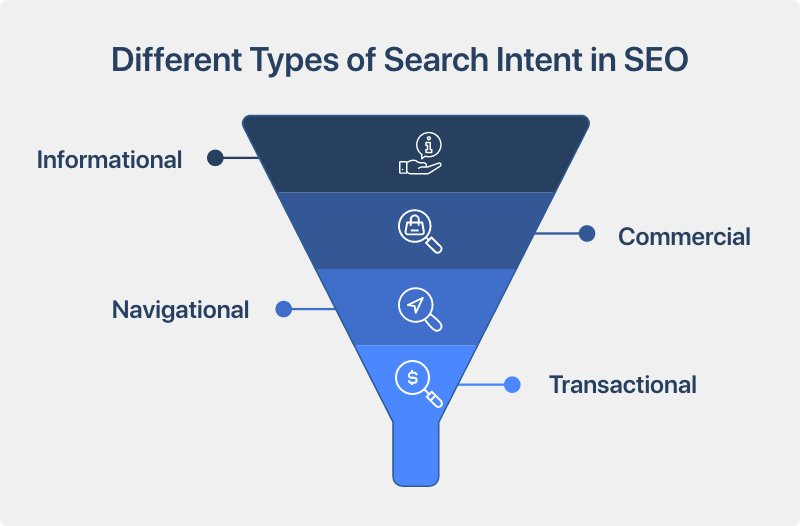
What Are the Different Types of Search Intent in SEO?
The four types of search intent in SEO are:
- Informational
- Commercial
- Navigational
- Transactional
Each type of search intent corresponds to a different part of the sales funnel. In local SEO, understanding the different types of search intent allows brands and marketing professionals to find the right local keywords to target, matching content to search intent to increase local search visibility and capture the attention of potential customers no matter where they are in their buying journey.
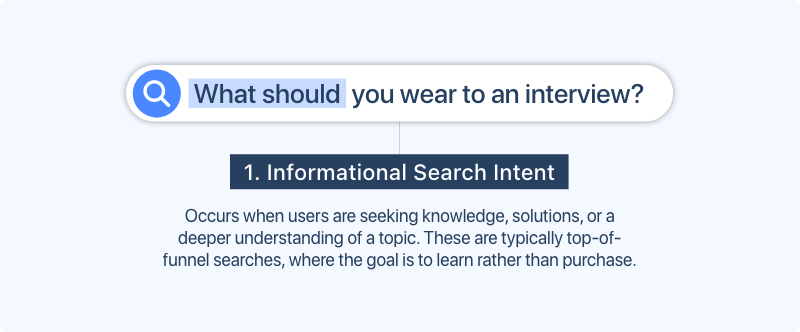
1. Informational Search Intent
Informational search intent occurs when users are seeking knowledge, solutions, or a deeper understanding of a topic. These are typically top-of-funnel searches, where the goal is to learn rather than purchase.
Targeting informational keywords can drive traffic to helpful content, particularly blog posts, and position a brand as an authority in the eyes of both customers and search engines. By answering common questions and providing valuable insights, businesses can increase brand recognition and guide potential customers toward the next stage of the buying process.
In many cases, informational searches are now being addressed through AI Overviews and other AI-powered search tools, making it important to optimize content for both traditional search and emerging AI platforms to increase local AI visibility.
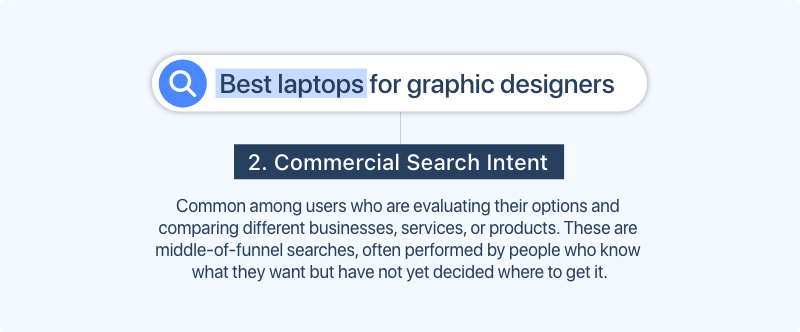
2. Commercial Search Intent
Commercial search intent is common among users who are evaluating their options and comparing different businesses, services, or products. These are middle-of-funnel searches, often performed by people who know what they want but have not yet decided where to get it.
Businesses can capture this intent by creating hyperlocal service pages, detailed location pages, and other targeted content that appears in geographically specific and "near me" style searches.
Because people are increasingly turning to AI tools such as ChatGPT to compare local businesses, optimizing for these searches can also boost visibility in AI-generated recommendations.
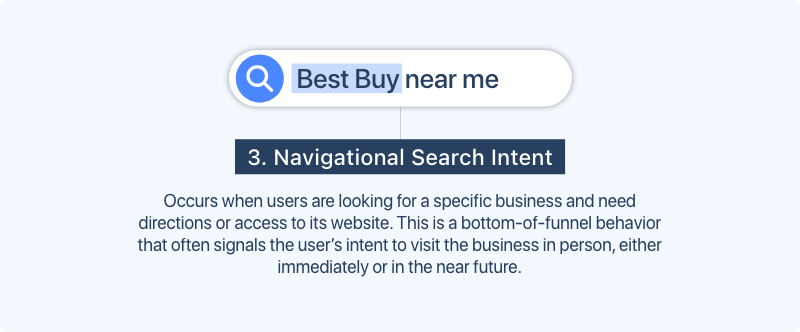
3. Navigational Search Intent
Navigational search intent occurs when users are looking for a specific business and need directions or access to its website. This is a bottom-of-funnel behavior that often signals the user's intent to visit the business in person, either immediately or in the near future.
These searches may include branded queries or terms like "open now" and "near me." Localized service pages and accurate location information help ensure that a business is easily found in these search scenarios, increasing the likelihood of a visit.
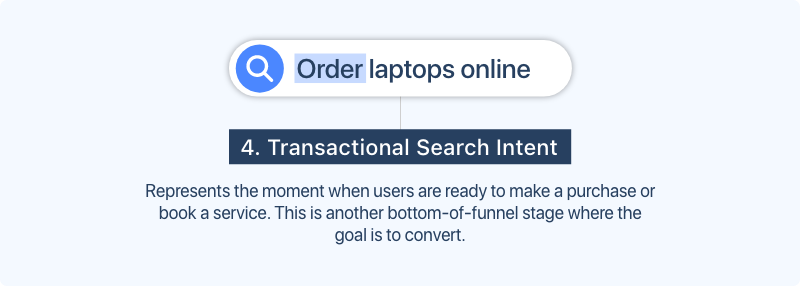
4. Transactional Search Intent
Transactional search intent represents the moment when users are ready to make a purchase or book a service. This is another bottom-of-funnel stage where the goal is to convert.
For service-area businesses and other service providers, this often means searches that lead directly to scheduling an appointment or completing an online order. By ensuring that booking processes are simple, calls to action are clear, and service offerings are well-presented, businesses can effectively capture this high-intent traffic.
How To Find Local Keywords for the Different Types of Search Intent
Effective local keyword research starts with the simple goal of building a balanced list that captures users at every stage of the buying journey. Begin by mapping your core services and common customer questions to the four types of search intent.
Informational queries will often include question words or how-to phrasing, commercial queries will include comparison language or research terms, navigational queries will include brand names, addresses, or phrases like "open now" and "near me", and transactional queries will contain purchase or booking signals such as "book", "buy", or "schedule". Framing your research around those signals keeps keyword selection aligned with what users actually want.
Start your list with seed keywords derived from your services, top-performing pages, and competitor listings, then expand using query suggestions, local modifiers, and keyword tools. Add geographic qualifiers such as neighborhoods, suburbs, and common local shorthand to turn generic queries into hyperlocal phrases.
As you expand, tag each keyword with an intent label and a short rationale, for example "informational: user asking how to solve a problem" or "transactional: user likely ready to book a service". That simple tagging step makes it much easier to group and prioritize keywords later.
Once you have a tagged list, group keywords into themes and map them to the content types that best match intent. Use blog posts and FAQ pages to capture informational traffic, comparison and service overview pages to capture commercial intent, localized location pages and accurate Google Business Profile information for navigational queries, and clear booking or product pages to convert transactional traffic. Prioritize keywords by a combination of search volume, local relevance, business value, and conversion likelihood, not by volume alone.
Validate intent by analyzing real search engine results pages. Look for local packs, map results, featured snippets, shopping listings, and AI overviews to confirm what search engines are serving for a given query. If a keyword returns mainly informational results but your page is transactional, adjust the copy and target a different keyword or create separate content that better matches user expectations. Intent can shift over time, so re-check SERP signals periodically and update your list accordingly.
To save time and add confidence to each decision, consider tools that surface intent and explain the reasoning behind keyword suggestions. Local Falcon's AI-powered Local Keyword Tool specifically shows the type of intent for each keyword suggestion based on AI reasoning. It also reveals the deeper logic behind each recommendation, helping you understand why a term is worth targeting beyond its basic intent label. That contextual view makes it easier to build a keyword plan that captures attention at every stage of the funnel and converts local searchers into loyal customers!
Finally, treat this as an iterative process. Track which pages earn clicks, conversions, and local visibility, then refine your keyword list, content strategy, and intent mappings based on real performance data. Over time that cycle will improve both traffic quality and conversion rates for your local business.
FAQs About the Different Types of Search Intent
What are the 4 types of search intent?
The four types of search intent are informational, commercial, navigational, and transactional. Each reflects a different stage of the buying journey, from researching a topic to making a purchase.
Why is search intent important in SEO?
Matching your content to the correct type of search intent ensures it meets user needs and aligns with what search engines expect to show. This improves both visibility and conversion potential.
How do I identify the type of search intent for a keyword?
You can review the search results for a keyword to see what types of pages rank, or use Local Falcon's Local Keyword Tool, which shows the type of intent for each keyword suggestion and explains the reasoning behind it.
Can one keyword have more than one search intent?
Yes. Some keywords can serve multiple intents depending on the context. For example, a branded term could be navigational for one user and commercial for another.
How can I target all types of search intent in my local SEO strategy?
Build a keyword list that includes terms for each intent type, then create content specifically tailored to match those intents. Use blog posts for informational searches, service or comparison pages for commercial searches, accurate location details for navigational searches, and strong calls to action for transactional searches.
Key Takeaways
Understanding the types of search intent is essential for creating content that resonates with local customers at every stage of their journey. Identifying whether a search is informational, commercial, navigational, or transactional helps you align your keywords, page types, and calls to action with what users actually want.
A balanced local SEO strategy targets all four intent types to build awareness, guide decision-making, and drive conversions. Tools like Local Falcon's Local Keyword Tool make this process easier by revealing both the intent category and the deeper reasoning behind each keyword, helping you make smarter, more effective targeting decisions.


